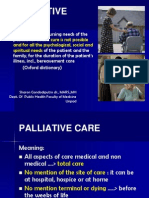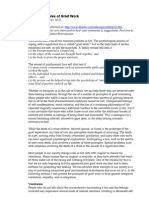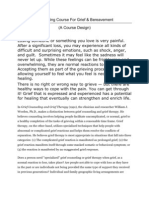0 ratings0% found this document useful (0 votes)
18 viewsLesson 12
Lesson 12
Uploaded by
Rizalyn Padua ReyThe document summarizes the hospice approach to caring for the dying. It discusses 7 key aspects:
1) Comforting and caring for patients by shifting the focus from curing to palliative care.
2) Using a team approach including medical professionals, clergy, social workers and volunteers to address physical, mental, emotional and spiritual needs.
3) Emphasis on pain and symptom control, recognizing chronic pain requires a different approach than acute pain.
4) Providing outpatient and home care whenever possible to keep patients comfortable in familiar surroundings.
5) Creating a home-like environment for inpatient care with patient comfort and privacy in mind.
6) Ensuring patients
Copyright:
© All Rights Reserved
Available Formats
Download as PPTX, PDF, TXT or read online from Scribd
Lesson 12
Lesson 12
Uploaded by
Rizalyn Padua Rey0 ratings0% found this document useful (0 votes)
18 views39 pagesThe document summarizes the hospice approach to caring for the dying. It discusses 7 key aspects:
1) Comforting and caring for patients by shifting the focus from curing to palliative care.
2) Using a team approach including medical professionals, clergy, social workers and volunteers to address physical, mental, emotional and spiritual needs.
3) Emphasis on pain and symptom control, recognizing chronic pain requires a different approach than acute pain.
4) Providing outpatient and home care whenever possible to keep patients comfortable in familiar surroundings.
5) Creating a home-like environment for inpatient care with patient comfort and privacy in mind.
6) Ensuring patients
Original Title
LESSON-12
Copyright
© © All Rights Reserved
Available Formats
PPTX, PDF, TXT or read online from Scribd
Share this document
Did you find this document useful?
Is this content inappropriate?
The document summarizes the hospice approach to caring for the dying. It discusses 7 key aspects:
1) Comforting and caring for patients by shifting the focus from curing to palliative care.
2) Using a team approach including medical professionals, clergy, social workers and volunteers to address physical, mental, emotional and spiritual needs.
3) Emphasis on pain and symptom control, recognizing chronic pain requires a different approach than acute pain.
4) Providing outpatient and home care whenever possible to keep patients comfortable in familiar surroundings.
5) Creating a home-like environment for inpatient care with patient comfort and privacy in mind.
6) Ensuring patients
Copyright:
© All Rights Reserved
Available Formats
Download as PPTX, PDF, TXT or read online from Scribd
Download as pptx, pdf, or txt
0 ratings0% found this document useful (0 votes)
18 views39 pagesLesson 12
Lesson 12
Uploaded by
Rizalyn Padua ReyThe document summarizes the hospice approach to caring for the dying. It discusses 7 key aspects:
1) Comforting and caring for patients by shifting the focus from curing to palliative care.
2) Using a team approach including medical professionals, clergy, social workers and volunteers to address physical, mental, emotional and spiritual needs.
3) Emphasis on pain and symptom control, recognizing chronic pain requires a different approach than acute pain.
4) Providing outpatient and home care whenever possible to keep patients comfortable in familiar surroundings.
5) Creating a home-like environment for inpatient care with patient comfort and privacy in mind.
6) Ensuring patients
Copyright:
© All Rights Reserved
Available Formats
Download as PPTX, PDF, TXT or read online from Scribd
Download as pptx, pdf, or txt
You are on page 1of 39
LESSON XII
The Hospice Approach to Care for
the Dying
The word hospice essentially meant a
refuge for wayfaring strangers. Now,
however, it refers to a place where tired,
sick, and dying people can be cared for and
comforted. The modern hospice does not
deal with acute cases or with emergency
medical care; rather, it seeks to help
patients live as comfortably and
meaningfully as they can until they die.
The hospice approach involves seven
different aspects of patient care. A close
examination of these will help to clarify
how hospices differ from hospitals and
other medical facilities.
Comforting and caring for patients. First of
all, the hospice approach emphasizes “comforting
and healing” patients. There comes a time in
every terminal illness when the possibility of
curing patients of their diseases no longer exists.
At this point, medical care should not be
discontinued nor should patients and their families
be abandoned; rather, the medical care should
shift from curing and healing “ to comforting and
caring for” the patients.
The emphasis here is on appropriate medical
treatment, which involves pain and symptom
control and assistance at all levels to patients and
their families until the patients die; it also means
continued assistance, when needed, to the patients’
families after they have died.
A team approach. Recognizing that
human beings have dimensions beyond the
physical, which is the basic focus of medicine,
the hospice approach utilizes a team concept
in its care for the dying. The team includes
patients, their families and friends, other
patients, doctors, nurses, priests, social
workers, physical and occupational therapists,
psychologists or psychiatrists, and volunteers.
Because sickness, dying , and death
involve all dimensions of people, their
mental and emotional, social and
religious needs must be met along with
the physical needs. The assumption is
that dying patients and their families
must have total care to get through
what can be and often is a difficult time.
Pain and symptom control. The hospice
approach recognizes that there is a difference
between “acute pain” and “chronic pain.”
Acute pain is that which will eventually
disappear – for example, the pain one feels after
surgery. Chronic pain, on the other hand, is that
type of pain that will not only disappear, but that
will also probably get worse. Obviously, a
completely different approach to controlling
pain must be used in dealing with the chronic
type.
Second, the hospice approach recognizes that pain,
especially chronic pain, is a complex phenomenon
that involves the mental or emotional, the social or
sociological, and the spiritual or religious aspects of
patients as well as the physical. This is another
reason why the hospice approach utilizes a team;
there is a basic recognition that social pain can be
helped by social workers; psychologists or
psychiatrists can alleviate mental and emotional pain,
and spiritual pain can be eased by priests/ministers.
Outpatient and home care. Because dying patients
do not as a rule need extraordinary medical care, they can
often be treated at home. Whenever possible, the hospice
approach encourages dying patients to remain at home,
offering both patients and their families total care and
support from the entire team whenever it is needed. This
brings greater “comfort” to the patients by allowing them
to stay in familiar surroundings with their families and
their own favorite belongings around them.
The key to this type of care is that complete support and
care must be available from the team. One of the reasons
more people have not chosen to die at home is that there
has been no support available to patients and families,
and families are not always able to cope alone with all of
the problems surrounding the dying of a loved one. If the
support is there, then the home is often the place where
the patients receive the best care and are most
comfortable.
Humanized in patient care. When home
care coupled with outpatient care is not
feasible – and many times it is not
humanized – homelike, comfortable
inpatient facilities should be available. A
patient should be place in wards so that they
can relate to others in similar situations. The
rooms should be warmly decorated and
should have large floor—to-ceiling,
curtained windows.
Patients should be allowed to have their own
familiar belongings around them and visiting
hours should be liberal, with no restrictions on age
that children can visit their parents and
grandparents. Food and drink of the patients’
choice ought to be available. And finally, patients
should be kept pain and symptom-free and be
given tender loving care, but they should be
spared the intrusion of extraordinary medical
technology, such as intravenous lines, respirators,
and so on.
Freedom from financial worry. All hospice care, on
– or outpatient should be performed on a non-profit
basis. Where available existing medical insurance,
private or government, should pay for as much as
possible, but not hospice patient should be refused
treatment because of lack of finances. Nor should
patients be dunned for money. Many hospices will tell
patients and families how much their care costs and
ask them if they can contribute anything toward their
care, but they are usually only asked once and never
refused treatment because they have no money.
Hospices mainly operate on fund-raising activities,
grants and donations, or memorial gifts for their
financial support. Also it has been proven that
keeping dying patients at home on an outpatient basis
or even in hospice facilities is far less expensive than
keeping them in convalescent homes or acute care
hospitals. This is not the main reason we should
consider the hospice approach. Rather, we should be
concerned with the humane and compassionate care
it provides for dying patients and their families.
Bereavement counseling and assistance.
Helping dying patients and their families adjust
to the fact of death before, during, and after its
occurrence is an important part of the hospice
approach. This is yet another reason that the
team approach is used – so that social workers,
priests/ministers, trained volunteers, and other
nonmedical members of the team can aid
medical personnel in caring for the entire family
unit.
Too often in our society the patient is
cared for and the family is forgotten.
When the patient dies, however, the
grieving family remains, and its members
often experience tremendous difficulty in
dealing with the death of their loved one.
If the family and the patient can be
treated as a unit during the dying period,
then much of the difficulty that might occur
after the patient dies can be averted – that is,
family members can go through at least
some of their mourning while the patient is
still with them.
Some Concluding Comments. The hospice
approach allows patients to die their own natural
deaths in peace and dignity with support from their
families, friends, the medical community, and
society in general. Because two of the main
reasons for mercy death and mercy killing are to
“put people out of their pain, suffering, and
misery” and to end lives that allegedly have no
meaning, the hospice approach obviates the need
for such measures in most instances.
If patients can die in peace and dignity, free
from pain and suffering, they will have no need
to commit suicide, assisted or otherwise, or
have their “lives or despair” terminated for
them. The reasons for mercy death and mercy
killing have not been completely eliminated,
but a humane alternative does exist in many
cases that might call for such drastic measures.
Attitudes Towards Death
Studies conducted on the manner in which dying
people react to death are classified into cognitive,
affective, and behavioral attitudes. Cognitive
attitudes which indicate how dying individuals
think about death include acceptance and denial.
The dying person simply accepts death as a part of
life, which is inevitable. Man is born to die. As the
Filipinos would say, “Lahat ng isinilang ay
mamamatay” (All that are born to die). On the
other hand, the dying individual may deny that
death is forthcoming.
One may not believe that one will die soon.
“Malakas pa ako, hindi pa ako mamamatay. “The
affective attitudes which bear out the feelings of the
dying individual may include depression, sense of
loss, and fear. The dying individual may include
depression, sense of loss, and fear. The dying
individual feels very bad and depressed about his/her
impending death. One just feels dejected, sad, and
lost. “Wala nang halaga and aking buhay, oras na
lamang ng kamatayan ang aking hinihintay.”
Finally, the behavioral attitudes include anger
or irritability, bargaining, resentment, and fear:
The dying person may become irritable, or may
easily become emotionally upset without reason
or cause. He usually becomes bitter and recentful
(e.g., “Kung hindi dahil sa aking pagpapakahirap
at pagsusumikap alang-alng sa kanyang pag-
aaral ay hindi sana ako magkaganito.” Or, Diyos
ko, bakit ako pa?” “Ang daming taong masasama,
bakit hindi pa sila ang nagdaranas ng ganito?”
A dying person’s bargaining attitude
towards death is best exemplified by
expressions such as: “Diyos ko, hwag
naman muna sana ngaun, maliliit pa ang
aking mga anak!” “Sana man lamang ay
mahintay ko pang makatapos ang aking
bunso.” “Diyos ko, huwag muna ninyo
akong kunin, marami pa ang dapat kong
gampanan sa buhay!”
In such instances, the dying individual tries to
bargain or to make an appeal: “Huwag pa
sana ngayon.” Fear my either be affective or
behavioral. One may be afraid to die: “Ayaw
ko pang mamatay.” “Tulungan ninyo ako,
doctor, gusto ko pang mabuhay.” Or, “Aanhin
ko pa ang lahat ng ito, and lahat ng
pinagpaguran ko, kung ako’y mamamatay.
Sayang, ang lahat. Naku,
nakapanghihinayang!”
The dying individual may waver
between any of the foregoing
attitudes before gradually
succumbing to the end.
Several Views of Death
Nikolai Berdyaev, a Russian theologian, states that
only death can give meaning to life. Without death,
life would be meaningless. Meaning is bound up with
the end. Thus, our last hope lies in death. Immortality
can be attained only through death. This is death’s
great paradox. Death, then is only a path, or an
intermission number between the present and the
hereafter.
Epicurus, the Athenean thinker,
argues: Either there is immortality
or theres none If there is, then we
should be glad there is death, for
once we are dead we shall become
immortal; if there is none, then death
is our final liberation from pain and
suffering.
In either case, therefore, we should not fear
death but be happy about it. Moreover,
continues Epicurus, if we are still alive,
death has not yet come; but once we are
dead, then death cannot touch us anymore.
Therefore, whether we are alive or dead,
death cannot touch us. We should not fear
death.
A German existentialist, Martin Heidegger,
views death as the completion of life, for unless and
until one dies, one’s life is not yet complete; hence
his concept of man as being – towards death. For
the Filipinos, “sa kabaong at libingan ang lahat ay
pantay-pantay; dukha’t cardinal magkaparis kung
mamatay” That is, death is a great equalizer of
men, for as far the coffin and the grave are
concerned, all are equal; whether you are a poor
individual or a cardinal, you are alike when you die.
Finally, John the evangelist quotes
Jesus Christ as saying: “I am the
resurrection and the life: he that believes
in me, though he were dead, shall live
again; and whoever lives and believes in
me shall never die”
Application of Ethical Theories
Natural law ethics regards death as a part of
nature; it declares that a person is dead once the
soul leaves the body. Although one can hardly
determine the precise point in time when the soul
has departed from the body, natural law moralists
do not disagree with the brain death definition.
Thus, when all vital functions of the brain
completely disappear or stop, extraordinary medical
measures may not be necessary but, in fact, useless.
Hence, it is morally wrong to prolong the
suffering of the dying individual by means of life-
sustaining machines in such circumstances. Let
nature take its own course.
On utilitarian principles, the brain death
definition seems to be in keeping with the utility
precept, i.e., promoting as much good as possible
and avoiding further harm and pain, if the dying
patient is detached from all life-supporting
machines. Even the donations of transplantable
vital organs, at least with informed consent, are
warranted by the greatest happiness (good) for the
greatest number principle.
In like manner, the pragmatist’s notions of
practicality, usefulness, and beneficiality may
justify the application of the brain death definition
issue in the medical context. Joseph Fletcher, of
course, with his situation ethics, accepts brain-
related criteria for pronouncing death in
conjunction with both euthanasia and organic
transplantations.
Rawls’s concept of justice may also justify
the unplugging of life-sustaining machines if and
when they are no longer useful to the dying
person – at least, in fairness to the patient, so that
they will not prolong his suffering. The same
holds true of Ross’s twofold principle by which to
resolve conflicting duties.
You might also like
- Nbde Ii - Test Packet II-m (2000-2008)Document35 pagesNbde Ii - Test Packet II-m (2000-2008)yalahopa95% (19)
- Top 5 Regrets of The DyingDocument5 pagesTop 5 Regrets of The Dyingcmkflorida70110% (3)
- Lesson 1Document8 pagesLesson 1Random RandomNo ratings yet
- Palliative Dr. WinemakerDocument32 pagesPalliative Dr. WinemakerEzhil Vendhan PalanisamyNo ratings yet
- Hospice Care sc2Document5 pagesHospice Care sc2Aziil LiizaNo ratings yet
- Hospice and Pallative CareDocument156 pagesHospice and Pallative CareKarla AguilarNo ratings yet
- Palliative CarefinalDocument13 pagesPalliative CarefinalPutri Senna RahayuNo ratings yet
- Project 2 FinalDocument7 pagesProject 2 Finalapi-583567694No ratings yet
- Death Dying and BereavementDocument5 pagesDeath Dying and BereavementImmatureBastardNo ratings yet
- Hospice Care PaperDocument12 pagesHospice Care Paperapi-247160803100% (2)
- Hospice and PallativeDocument38 pagesHospice and PallativeVhe Pacatang100% (1)
- Hospice Powerpoint LectureDocument161 pagesHospice Powerpoint LectureFrancis Emman Santiago0% (1)
- Diagnosing Dying (The Last Hours or Days of Life)Document2 pagesDiagnosing Dying (The Last Hours or Days of Life)Quezelyne Bella GuillermoNo ratings yet
- Final End of Life Care-FinalDocument8 pagesFinal End of Life Care-FinalYounas BhattiNo ratings yet
- Principles of Long-Term Care and Palliative CareDocument3 pagesPrinciples of Long-Term Care and Palliative CareGEN ERIGBUAGAS100% (1)
- Lecture # 1 Elective 1 IntroDocument25 pagesLecture # 1 Elective 1 IntroCiella Ako100% (1)
- ElectiveDocument35 pagesElectivedeeNo ratings yet
- 28 - Family Caregiving and End of Life CareDocument10 pages28 - Family Caregiving and End of Life CareSameera DahamNo ratings yet
- Grief Work BlatnerDocument7 pagesGrief Work Blatnerbunnie02100% (1)
- L14 Reading Reflections Study GuideDocument5 pagesL14 Reading Reflections Study GuideMaria Camila Vangh-egas JNo ratings yet
- Ego Integrity Vs Despair (Comp App)Document10 pagesEgo Integrity Vs Despair (Comp App)Arianne BugnaNo ratings yet
- Group 9 - DYING AND BEREAVEMENTDocument6 pagesGroup 9 - DYING AND BEREAVEMENTRay Sophia CuberoNo ratings yet
- The Role of the Spiritual Caregiver to the Terminally Ill PatientsFrom EverandThe Role of the Spiritual Caregiver to the Terminally Ill PatientsRating: 5 out of 5 stars5/5 (1)
- CHCPAL001: Deliver Care Services Using A Palliative ApproachDocument47 pagesCHCPAL001: Deliver Care Services Using A Palliative ApproachRuby Rafanan-Kettyle0% (1)
- End of Life CommunicationDocument27 pagesEnd of Life CommunicationjintuNo ratings yet
- week-10-PPT-NCM108-HEALTH-ETHICS (20241010101554)Document52 pagesweek-10-PPT-NCM108-HEALTH-ETHICS (20241010101554)stephanie Ann PlanciaNo ratings yet
- Aims of End of LifeDocument1 pageAims of End of Lifejaxking60No ratings yet
- Ensuring Competent Care at The End of Life - A Life Long ProcessDocument32 pagesEnsuring Competent Care at The End of Life - A Life Long ProcessmatrixtrinityNo ratings yet
- Lecture 9. Special Care - Terminal & Palliative CareDocument25 pagesLecture 9. Special Care - Terminal & Palliative CareAnn Heerah100% (1)
- Module 6 Death and DyingDocument38 pagesModule 6 Death and DyingZaren James D. RacaNo ratings yet
- Principles of Palliative Care (Edited) PPC-1Document33 pagesPrinciples of Palliative Care (Edited) PPC-1Mohamed Saeed BachooNo ratings yet
- wk14PR 1.editedDocument8 pageswk14PR 1.editedOscarNo ratings yet
- Reimagine Well Learn Guide: Palliative Care: A Holistic Approach to Life-Limiting DiseaseFrom EverandReimagine Well Learn Guide: Palliative Care: A Holistic Approach to Life-Limiting DiseaseNo ratings yet
- 7 Important Euthanasia Pros and ConsDocument2 pages7 Important Euthanasia Pros and ConsChristian ArbolerasNo ratings yet
- ServicesDocument23 pagesServicesZllison Mae Teodoro MangabatNo ratings yet
- Chapter 15 PsychDocument2 pagesChapter 15 Psychkelemadu.15No ratings yet
- Bereavement in Adult LifeDocument9 pagesBereavement in Adult LifeAzhar MastermindNo ratings yet
- About HospiceDocument6 pagesAbout HospicemonabertNo ratings yet
- Trans CulturalDocument6 pagesTrans CulturalAlyssa Santos JavierNo ratings yet
- Palliative CareDocument117 pagesPalliative Caremuuminshafic11No ratings yet
- Palliative CareDocument23 pagesPalliative CareCharles Frank100% (2)
- Case StudyDocument62 pagesCase StudyIyalisaiVijay50% (2)
- EuthanasiaDocument5 pagesEuthanasiaDrei AtancioNo ratings yet
- Living at the End of Life: A Hospice Nurse Addresses the Most Common QuestionsFrom EverandLiving at the End of Life: A Hospice Nurse Addresses the Most Common QuestionsRating: 4 out of 5 stars4/5 (4)
- Illness ExperienceDocument15 pagesIllness ExperienceGUrpreet SinghNo ratings yet
- Ism Fall Final Project Alyssa OsborneDocument37 pagesIsm Fall Final Project Alyssa Osborneapi-381980344No ratings yet
- Philosophy of Nursing EditedDocument10 pagesPhilosophy of Nursing Editedapi-295425485No ratings yet
- MT NotesDocument26 pagesMT NotesMaisonNo ratings yet
- CHCPAL001 Deliver Care Services Using A Palliative ApproachDocument11 pagesCHCPAL001 Deliver Care Services Using A Palliative ApproachAfifa M Afzal100% (1)
- Nursing and End of Life CareDocument100 pagesNursing and End of Life CareRembrandt PacangNo ratings yet
- Nurses Roles in Stages of Death 000Document5 pagesNurses Roles in Stages of Death 000Dauda UsmanNo ratings yet
- Hospice and Palliative CareDocument8 pagesHospice and Palliative Caredavidhanley2226715No ratings yet
- Care of Dying and DeadDocument10 pagesCare of Dying and Deadd1choosenNo ratings yet
- Palliative Care: Basic TerminologiesDocument7 pagesPalliative Care: Basic TerminologiesDagmawit Girma100% (1)
- Counseling Course For GriefDocument3 pagesCounseling Course For GriefRita Lim Seno-OgbinarNo ratings yet
- Philosophy 1: Philosophy Paper Stevie A. Williams The University of TulsaDocument8 pagesPhilosophy 1: Philosophy Paper Stevie A. Williams The University of Tulsasteviestevie333No ratings yet
- End of Life CareDocument15 pagesEnd of Life CareAnonymous gEGf1C100% (4)
- Crisis InterventionDocument109 pagesCrisis InterventionchaarviNo ratings yet
- Where Problems With The Heart Mean There Isn't Enough Oxygen Present in The BloodDocument6 pagesWhere Problems With The Heart Mean There Isn't Enough Oxygen Present in The BloodRizalyn Padua ReyNo ratings yet
- Lesson 11Document86 pagesLesson 11Rizalyn Padua ReyNo ratings yet
- Family Health Nursing Problem and Family Care PlanDocument5 pagesFamily Health Nursing Problem and Family Care PlanRizalyn Padua ReyNo ratings yet
- Checklist 1Document3 pagesChecklist 1Rizalyn Padua ReyNo ratings yet
- Midterm FetalDocument4 pagesMidterm FetalRizalyn Padua ReyNo ratings yet
- Naming Compounds ChemistryDocument58 pagesNaming Compounds ChemistryRizalyn Padua Rey100% (1)
- Chapter 15 FinalDocument21 pagesChapter 15 FinalRizalyn Padua ReyNo ratings yet
- Home VisitDocument7 pagesHome VisitRizalyn Padua ReyNo ratings yet
- Chapter 1Document5 pagesChapter 1Rizalyn Padua ReyNo ratings yet
- Ascites in ChildrenDocument7 pagesAscites in Childrentriska antonyNo ratings yet
- Totalpsa ArcDocument8 pagesTotalpsa Arctesteste testeNo ratings yet
- Medical English - Ending The Opioid Epidemic-A Call To ActionDocument3 pagesMedical English - Ending The Opioid Epidemic-A Call To ActionfuilungwongNo ratings yet
- QUIZ Critical Thinking in Nursing PracticeDocument16 pagesQUIZ Critical Thinking in Nursing Practicegabrielle magdaraogNo ratings yet
- Brochure Arogya Sanjeevani Policy V 1 0204 Web PDFDocument8 pagesBrochure Arogya Sanjeevani Policy V 1 0204 Web PDFsurendra reddyNo ratings yet
- Raman Spectroscopy Vs Quantitative Polymerase ChaiDocument10 pagesRaman Spectroscopy Vs Quantitative Polymerase ChaiSudip RoyNo ratings yet
- 2022 Virtual Eprs ForumDocument122 pages2022 Virtual Eprs ForumAljhan LingaNo ratings yet
- Health & Physical Education PDFDocument210 pagesHealth & Physical Education PDFNatnael SolomonNo ratings yet
- Annexes and ReferencesDocument44 pagesAnnexes and ReferencesMaricel AquinoNo ratings yet
- Malmstrom Et Al - 1999 - Oral Montelukast, Inhaled Beclomethasone, and Placebo For Chronic AsthmaDocument10 pagesMalmstrom Et Al - 1999 - Oral Montelukast, Inhaled Beclomethasone, and Placebo For Chronic AsthmaRutvik ShahNo ratings yet
- Cardiac DysrhythmiasDocument3 pagesCardiac DysrhythmiasWilbert GuerreroNo ratings yet
- Module Vi - Neleco2Document8 pagesModule Vi - Neleco2claudine padillon100% (1)
- Medicinal Properties of True' Cinnamon (Cinnamomum Zeylanicum) : A Systematic ReviewDocument10 pagesMedicinal Properties of True' Cinnamon (Cinnamomum Zeylanicum) : A Systematic Reviewdyah ayu noer fadilaNo ratings yet
- Oligohydraminos PTDocument8 pagesOligohydraminos PTArpita ArpitaNo ratings yet
- Lesson Plan For Kindergarten: Teacher Name Date of Lesson Name of School Little Astorian GradeDocument5 pagesLesson Plan For Kindergarten: Teacher Name Date of Lesson Name of School Little Astorian Gradeapi-512431732No ratings yet
- KamiasDocument3 pagesKamiasIrene Carla Lacson Medina0% (1)
- Community House To House Philpen AssesmentDocument6 pagesCommunity House To House Philpen AssesmentDianna AsugNo ratings yet
- Maria Case Study 2Document2 pagesMaria Case Study 2api-316574434No ratings yet
- Clinic Room (Prices)Document2 pagesClinic Room (Prices)mohammed alaidroosNo ratings yet
- SpirulinaDocument10 pagesSpirulinanavneetkaur0866No ratings yet
- Musculoskeletal Assessment by Waqas AnjumDocument5 pagesMusculoskeletal Assessment by Waqas AnjumWaqas Anjum HayatNo ratings yet
- BURNS BurnDocument5 pagesBURNS BurnWiljohn de la CruzNo ratings yet
- Smith 1957Document7 pagesSmith 1957Emanuel MartinezNo ratings yet
- Form 3 Biology Revision Test First Term 2022: Answer All Questions On A Separate Answer Sheet ProvidedDocument2 pagesForm 3 Biology Revision Test First Term 2022: Answer All Questions On A Separate Answer Sheet ProvidedGiftElishaNdawalaNo ratings yet
- Nursing Standard PrinciplesDocument2 pagesNursing Standard PrinciplesRoscelie KhoNo ratings yet
- Extraction of Primary Teeth in Children: An Observational StudyDocument6 pagesExtraction of Primary Teeth in Children: An Observational StudyhayiarNo ratings yet
- Shapes and Arrangements of BacteriaDocument22 pagesShapes and Arrangements of BacteriaCarl Elexer Cuyugan Ano100% (3)
































































































